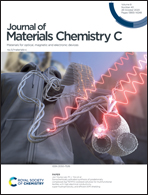Broadband organic photodetectors based on ternary blend active layers with enhanced and spectrally flat response†
Abstract
It is greatly in demand but still challenging to achieve organic photodetectors (OPDs) having both spectrally flat response from ultraviolet to near-infrared and high external quantum efficiencies (EQEs). Herein, ternary photomultiplication (PM)-type OPDs are fabricated with two donors and one acceptor in the bulk-heterojunction (BHJ) active layers. Under −25 V bias, the optimized ternary OPD exhibits a relatively flat EQE spectrum from 330 to 810 nm with an average EQE of 3.3 × 105% which is more than 40 times larger than that of the binary OPD. In particular, an EQE up to 5.1 × 105% at 380 nm is obtained for the ternary OPD, representing a record high value among all reported OPDs to the best of our knowledge. Compared to the binary OPD under −25 V bias and 380 nm light illumination, the linear response range of the ternary OPD under the same conditions is 4.5 times larger. Moreover, the ternary OPD shows a rise time of ∼42 ms which is more than one-fold faster than the binary OPD under the same conditions. Therefore, a ternary BHJ provides an effective strategy to develop broadband OPDs with improved EQEs, extended linear response range, faster response, and spectrally flat response from the ultraviolet to the near-infrared region.



 Please wait while we load your content...
Please wait while we load your content...